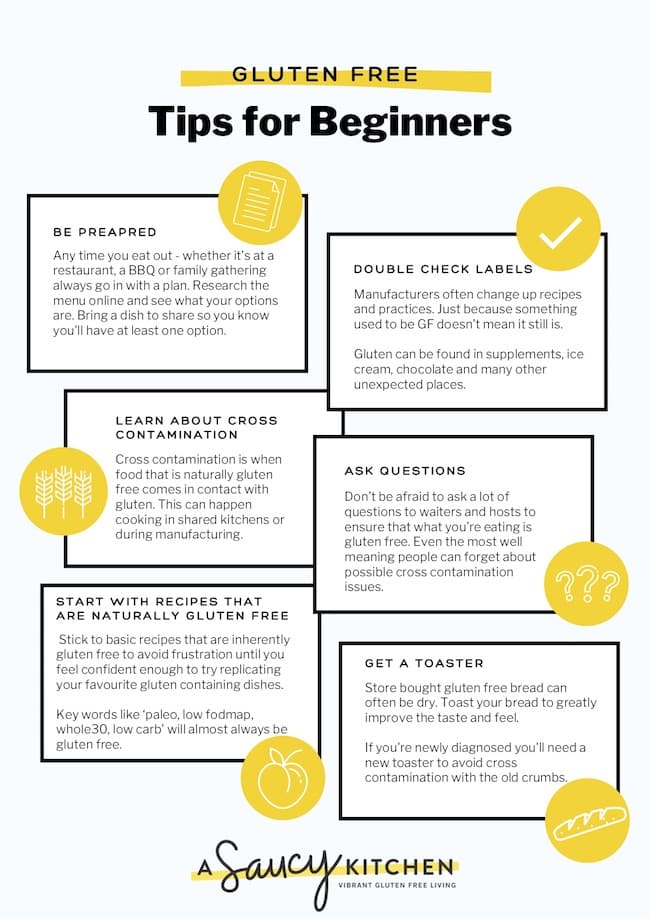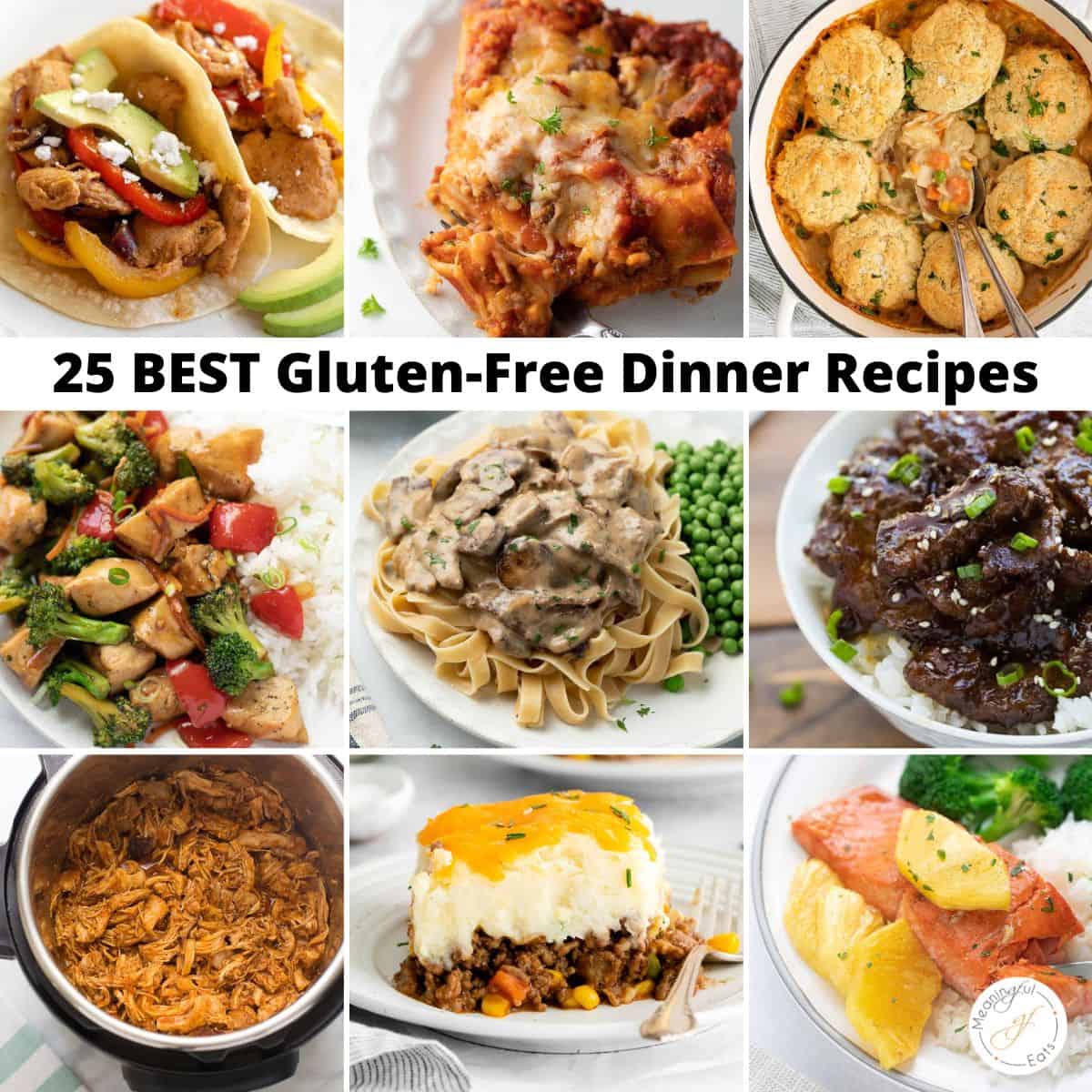Gluten-free recipes for beginners offer simple and delicious options for those avoiding gluten in their diet. Embarking on a gluten-free lifestyle can be daunting, but with the right recipes, it can also be enjoyable and satisfying.
From breakfast to dinner, snacks to desserts, there is a wide variety of gluten-free recipes that cater to different tastes and dietary needs. We will explore some easy and tasty gluten-free recipes that even beginners can try. Whether you have a gluten intolerance or simply want to explore a new way of cooking and eating, these recipes will help you on your gluten-free journey.
So, let’s dive in and discover some delightful gluten-free dishes that you can prepare with minimal effort and ingredients.

Credit: www.asaucykitchen.com
Understanding Gluten And Gluten-free Diet
Discover the essentials of gluten and how it affects your diet. Explore a range of beginner-friendly gluten-free recipes to kickstart your journey to a healthier lifestyle.
What Is Gluten?
Gluten is a type of protein found in grains such as wheat, barley, and rye. It is what gives dough its elastic texture, allowing bread to rise and gives pasta its chewy texture. However, for people with celiac disease or gluten sensitivity, consuming gluten can lead to unpleasant symptoms and long-term health issues.
Why Go Gluten-free?
There are several reasons why one might choose to adopt a gluten-free diet. For individuals with celiac disease, consuming gluten triggers an immune response that damages the lining of the small intestine, leading to nutrient deficiencies and various health problems. Others may have non-celiac gluten sensitivity, experiencing digestive issues, fatigue, and joint pain when they consume gluten.
Basics Of A Gluten-free Diet
Adopting a gluten-free diet involves eliminating all foods and ingredients that contain gluten. This includes avoiding wheat-based products like bread, pasta, and baked goods, as well as anything made with barley or rye. However, there are plenty of delicious gluten-free options available to incorporate into your meals.
Here are some key principles to keep in mind when following a gluten-free diet:
- Focus on naturally gluten-free foods: Opt for fruits, vegetables, lean meats, fish, and poultry, as well as rice, quinoa, potatoes, and legumes. These are all naturally gluten-free and provide essential nutrients.
- Read labels carefully: Many processed foods may contain hidden sources of gluten, such as soy sauce, salad dressings, and seasonings. Be diligent in reading labels to ensure you are choosing gluten-free options.
- Seek out gluten-free alternatives: Nowadays, there is a wide variety of gluten-free alternatives available in the market. You can find gluten-free bread, pasta, cereals, and even baking mixes made from alternative grains like rice, corn, and quinoa.
- Be aware of cross-contamination: To prevent accidental gluten exposure, it’s important to avoid cross-contamination. This means using separate utensils, cutting boards, and cooking equipment when preparing gluten-free meals.
By understanding what gluten is, why some individuals need to go gluten-free, and the basics of a gluten-free diet, you can embark on a journey towards tasty and nutritious gluten-free cooking. The next step is exploring gluten-free recipes that are beginner-friendly and delicious.
:max_bytes(150000):strip_icc():focal(879x939:881x941)/one-pot-garlicky-shrimp-and-broccoli-c3575c22923b4f5b814c704a5dcc316d.jpg)
Credit: www.eatingwell.com
Essential Ingredients For Gluten-free Cooking
Discover the essential ingredients needed for beginners in gluten-free cooking. Explore a range of delicious and easy gluten-free recipes that are perfect for anyone starting their journey towards a gluten-free lifestyle.
When it comes to gluten-free cooking, having the right ingredients on hand is essential for delicious and satisfying dishes. Whether you are new to a gluten-free diet or simply want to expand your culinary horizons, understanding the key components of gluten-free cooking will set you up for success. In this post, we will explore the essential ingredients that every beginner should have in their gluten-free pantry.
Gluten-free Grains And Flours
Gluten-free grains and flours are the foundation of many gluten-free recipes. They not only impart unique flavors and textures but also provide a nutritious alternative to traditional wheat-based products. Here are some must-have gluten-free grains and flours:
- Brown rice flour: A versatile gluten-free flour that can be used in a wide range of recipes, from pancakes to bread.
- Quinoa: A protein-packed grain that can be used as a base for salads, side dishes, and even desserts.
- Buckwheat flour: Despite its name, buckwheat is gluten-free and makes a great flour for pancakes, crepes, and noodles.
- Almond flour: This nutrient-rich flour adds a delicate nutty flavor to baked goods and is perfect for gluten-free desserts.
Alternative Thickeners And Binders
Thickening agents and binders are essential for creating the right texture in gluten-free recipes. These gluten-free alternatives will help you achieve that desired consistency without compromising taste:
- Arrowroot starch: A natural thickener that works well in sauces, soups, and gravies.
- Tapioca flour/starch: Known for its ability to provide a chewy texture, tapioca flour is great for puddings, bread, and pies.
- Xanthan gum: A common binder used in gluten-free baking to replace the elasticity typically provided by gluten.
- Psyllium husk: A fiber-rich ingredient that can be used as a binding agent in bread and other baked goods.
Gluten-free Baking Essentials
Gluten-free baking requires a slightly different approach and a few key ingredients to ensure success. These gluten-free baking essentials are essential for achieving light and fluffy baked goods:
- Gluten-free baking powder: A leavening agent that helps baked goods rise and stay tender.
- Gluten-free baking soda: Another leavening agent commonly used in gluten-free baking recipes.
- Rice milk or almond milk: Dairy-free alternatives that can be used in place of regular milk to add moisture and flavor.
- Coconut oil or vegetable oil: These oils provide moisture and contribute to the overall texture of gluten-free baked goods.
By stocking your pantry with these essential ingredients, you will have the foundation to create a wide variety of delicious and satisfying gluten-free recipes. Experiment with different combinations and let your creativity shine as you embark on your gluten-free cooking journey!
Easy And Delicious Gluten-free Recipes
If you’re a beginner looking to embrace a gluten-free lifestyle, you might be wondering where to start with your meals. The good news is that there are plenty of easy and delicious gluten-free recipes that will satisfy your taste buds while keeping you healthy. Whether you’re looking for breakfast ideas, lunch and dinner options, or delightful gluten-free desserts, we’ve got you covered!
Breakfast Ideas
Starting your day with a nutritious and gluten-free breakfast sets the tone for a successful day ahead. Luckily, there are various options to choose from:
- Scrambled eggs with fresh vegetables and avocado chunks.
- Smoothie bowls packed with fruits, seeds, and a dollop of Greek yogurt.
- Quinoa porridge topped with berries and a sprinkle of cinnamon.
| Breakfast Ideas | Ingredients | Preparation Time |
|---|---|---|
| Scrambled eggs with fresh vegetables and avocado chunks | Eggs, bell peppers, onions, tomatoes, avocado | 15 minutes |
| Smoothie bowls packed with fruits, seeds, and a dollop of Greek yogurt | Assorted fruits, chia seeds, spinach, Greek yogurt | 10 minutes |
| Quinoa porridge topped with berries and a sprinkle of cinnamon | Quinoa, almond milk, berries, cinnamon | 20 minutes |
Lunch And Dinner Options
When it comes to lunch and dinner, gluten-free recipes offer a wide array of choices to satisfy your cravings:
- Grilled chicken breast with a side of roasted vegetables.
- Quinoa salad with fresh herbs, cherry tomatoes, and feta cheese.
- Salmon fillet with lemon and dill, served with steamed asparagus.
| Lunch and Dinner Options | Ingredients | Preparation Time |
|---|---|---|
| Grilled chicken breast with a side of roasted vegetables | Chicken breast, mixed vegetables, olive oil, herbs | 30 minutes |
| Quinoa salad with fresh herbs, cherry tomatoes, and feta cheese | Quinoa, herbs, cherry tomatoes, feta cheese, lemon juice | 20 minutes |
| Salmon fillet with lemon and dill, served with steamed asparagus | Salmon fillet, lemon, dill, asparagus | 25 minutes |
Delightful Gluten-free Desserts
No meal is complete without a sweet treat, and gluten-free desserts can be just as indulgent:
- Fresh fruit salad with a drizzle of honey and a sprinkle of shredded coconut.
- Flourless chocolate cake topped with whipped cream and fresh berries.
- Chia seed pudding with vanilla extract and a dash of cinnamon.
| Delightful Gluten-Free Desserts | Ingredients | Preparation Time |
|---|---|---|
| Fresh fruit salad with a drizzle of honey and a sprinkle of shredded coconut | Assorted fruits, honey, shredded coconut | 15 minutes |
| Flourless chocolate cake topped with whipped cream and fresh berries | Dark chocolate, eggs, sugar, whipped cream, berries | 45 minutes |
| Chia seed pudding with vanilla extract and a dash of cinnamon | Chia seeds, almond milk, vanilla extract, cinnamon | 5 minutes (plus overnight chilling) |
With these easy and delicious gluten-free recipes, you won’t feel like you’re missing out on anything. Start your gluten-free journey today and savor the flavors of a healthy, fulfilling lifestyle!

Credit: meaningfuleats.com
Frequently Asked Questions Of Gluten-free Recipes For Beginners
What Can I Eat For Dinner That Is Gluten-free?
For a gluten-free dinner, choose dishes like grilled chicken, roasted veggies, or salmon with a side of quinoa. Enjoy stir-fried tofu with rice noodles or a hearty salad with fresh ingredients. Avoid gluten-containing foods like bread, pasta, and sauces thickened with wheat flour.
What Foods Should You Avoid On A Gluten-free Diet?
Avoid all foods containing gluten, including wheat, barley, rye, and their derivatives. This includes bread, pasta, cereal, and baked goods made with these ingredients. Check labels for gluten-free certification to ensure no hidden sources of gluten.
Does Rice Contain Gluten?
No, rice does not contain gluten. It is a gluten-free food option.
What Happens When You Eat Gluten After Not Eating It For A While?
Eating gluten after avoiding it can cause symptoms like stomach pain, bloating, and diarrhea due to gluten intolerance. It’s important to maintain a gluten-free diet if you have celiac disease or non-celiac gluten sensitivity to prevent discomfort and promote overall health.
Conclusion
Whether you have recently adopted a gluten-free diet or simply want to explore new culinary horizons, these beginner-friendly gluten-free recipes will surely delight your taste buds. From mouthwatering mains to delectable desserts, this collection has something for everyone. With easy-to-understand instructions and a variety of ingredients, you can confidently embark on your gluten-free cooking journey.
Say goodbye to the worries of gluten and hello to a world of delicious possibilities. Start experimenting today and indulge in the joys of gluten-free cooking.